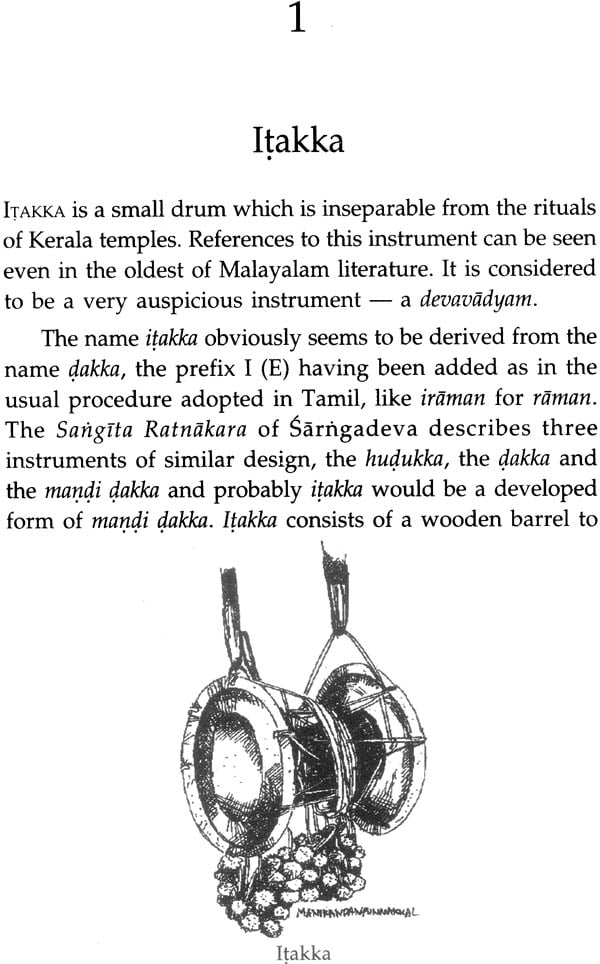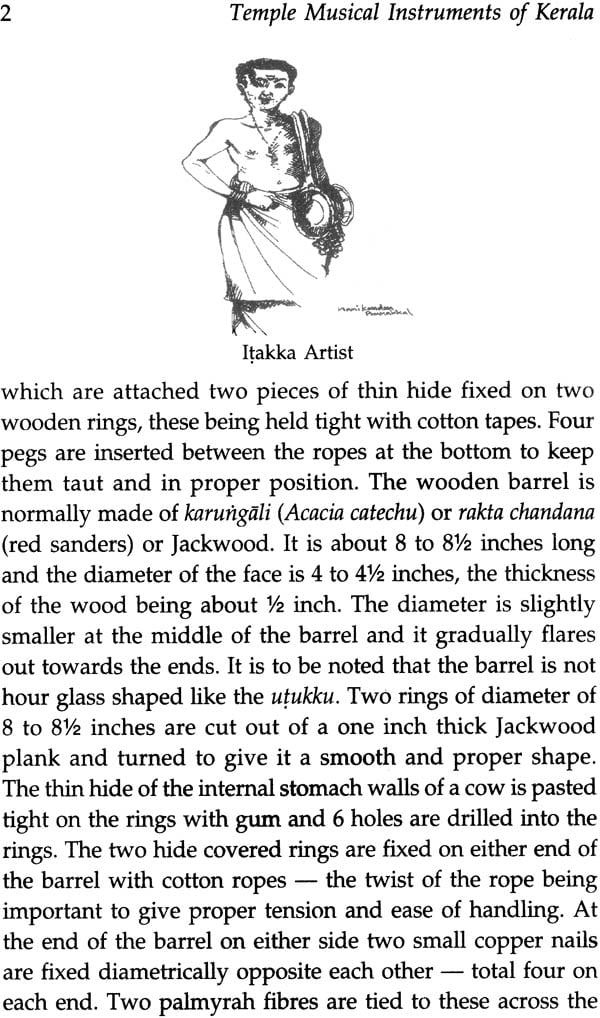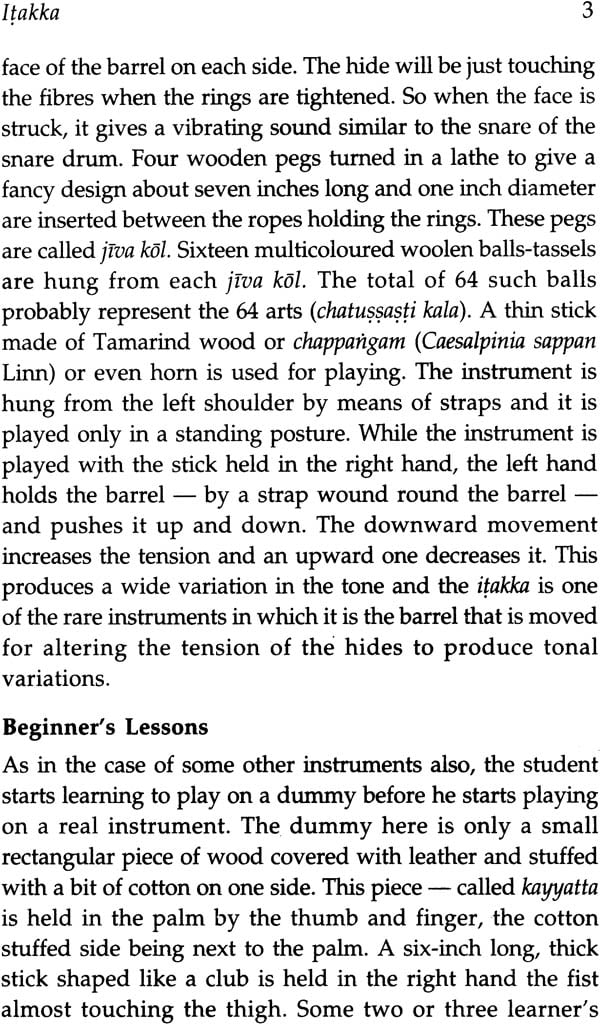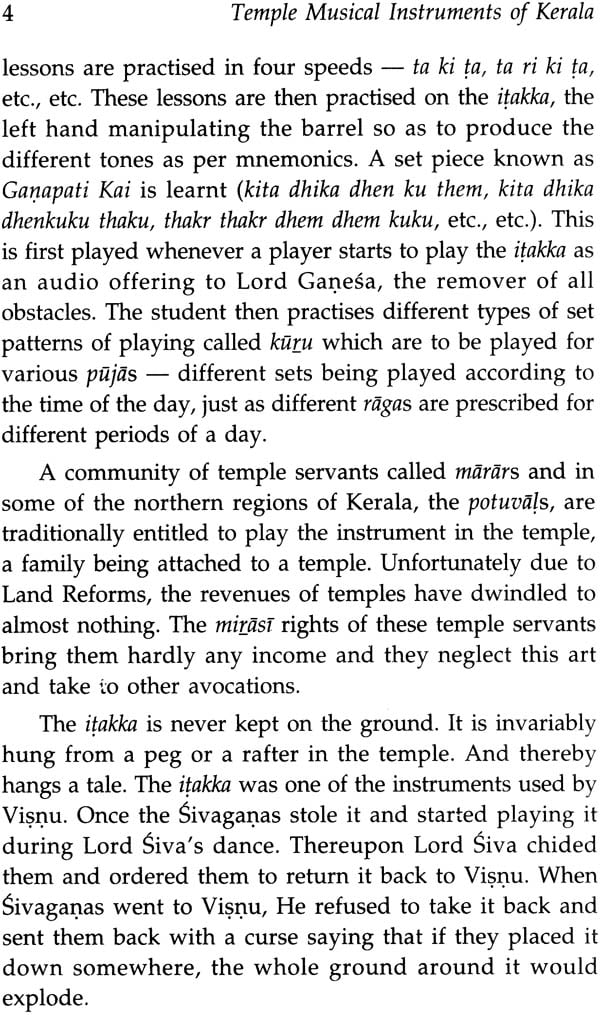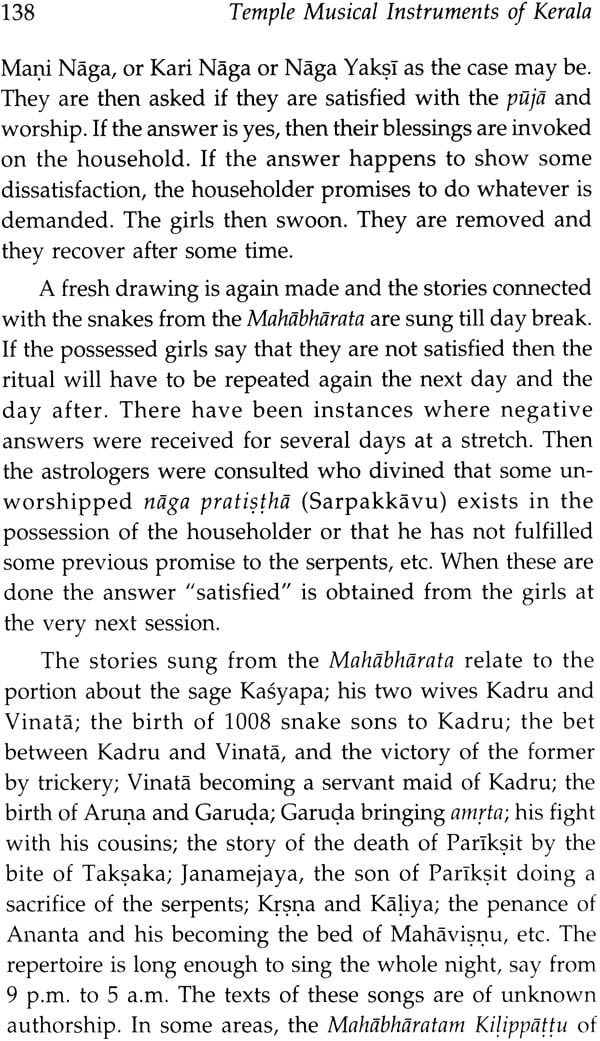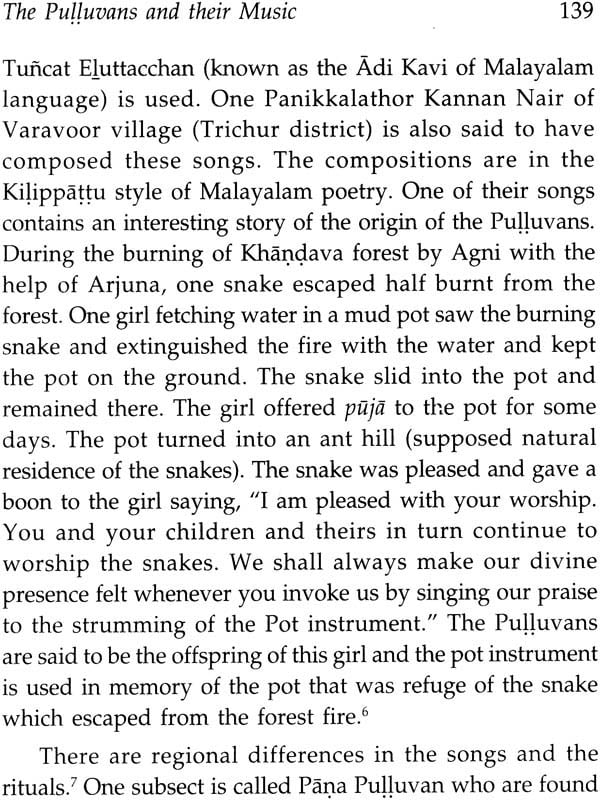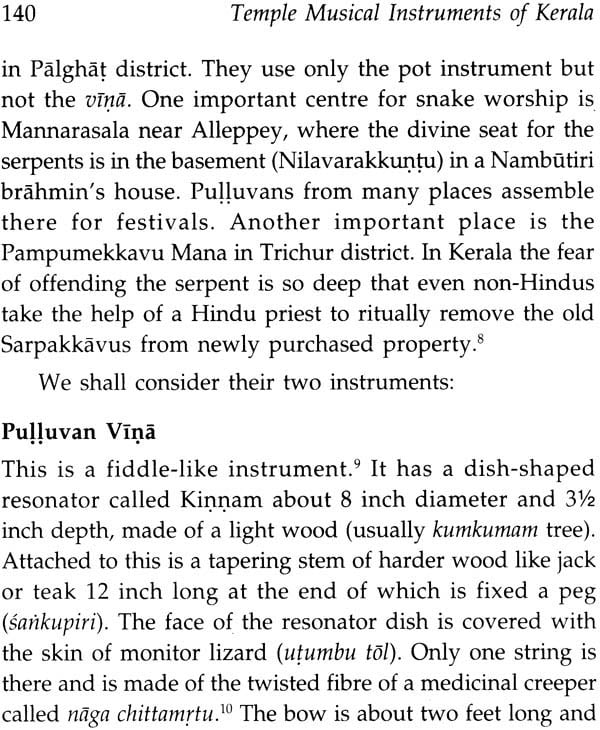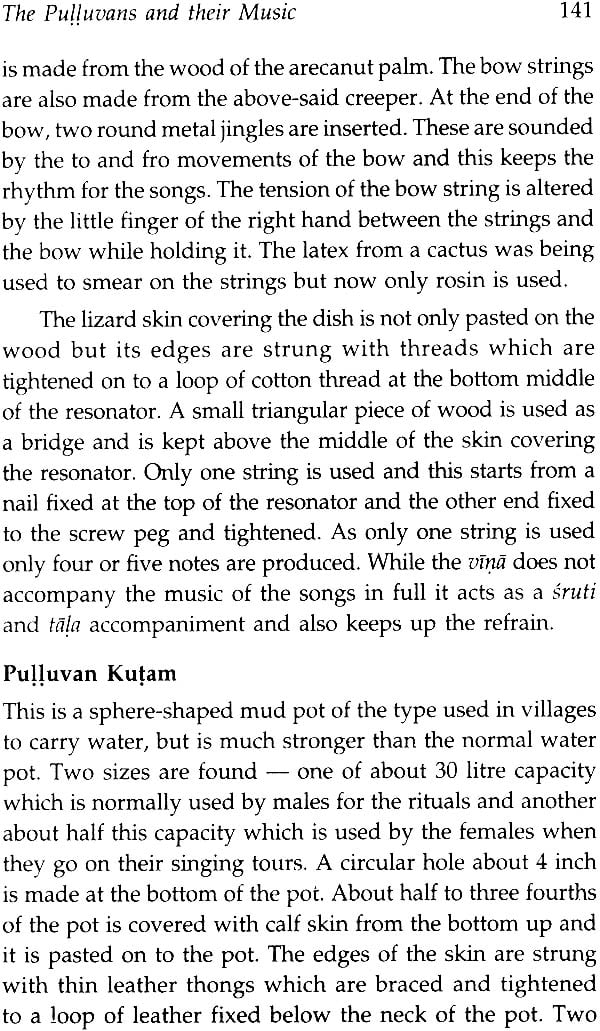
Temple Musical Instruments of Kerala
Book Specification
| Item Code: | IHF098 |
| Author: | L.S. Rajagopalan Edited byA. Purushothaman and A. Harindranath |
| Publisher: | D. K. Printworld and Sangeet Natak Akademi |
| Language: | English |
| Edition: | 2010 |
| ISBN: | 9788124605448 |
| Pages: | 168 (9 B/W Illustration) |
| Cover: | Hardcover |
| Other Details | 8.8” X 5.8” |
| Weight | 400 gm |
Book Description
From the Jacket
The performing arts of Kerala - Kathakali, Kutiyattam, Mohiniattam, and other forms of dance and drama - occupy a vital space in India’s creative imagination. All these performances move to a music that is supported by Kerala’s indigenous musical instruments - a variety of drums and clappers, as well as a smaller number of pipes and strings.
Quite a few of these instruments are also found associated with rituals and festivities in the temples of Kerala: the Itakka, Chenta, Timila, Milavu, Suddha Maddalam - all membranophones; the aerophones Kurum Kulal and Kompu Vadyam; and Ilattalam, an idiophone. Notes on these instruments by a devoted student of the performing arts of Kerala are put together in this small volume-the first English-language publication on the subject. Illustrations of each instrument accompany the texts.
The author brings to his task the benefit of an intimate knowledge of each instrument, acquired through years of fieldwork, as well as an erudition born of his immersion in literary classics in Tamil, Malayalam and Sanskrit. The pieces here are a source too of the folklore associated with Kerala’s musical instruments. The chief strength of the book, however, lies in the precise information it provides on each instrument - its dimensions, materials, construction, playing techniques, methods of training, and, not least, its music.
Apart from musicians and musicologists, this book would interest students of Kerala’s folklore and anthropology, as well as general readers with a special interest in the arts and culture of Kerala.
L.S. /Rajagopalan (1922-2008) enjoyed a well-deserved reputation as an authority on the traditional theatre and music of Kerala. He studied and explored these arts all his life - in temple precincts, the countryside, and the by-lanes of town and city - and sought to unravel their meaning through his writing, lectures, and personal guidance in scholarly fieldwork. Rajagopalan’s special interests lay in Krsnattam, Kutiyattam, Kathakali, and the folk music and musical instruments of Kerala. He had also delved deep into the musical aspects of Vedic chanting and Carnatic music.
Rajagopalan’s publications include Women’s Role in Kutiyattam (1997), and Kutiyattam: Preliminaries and Performance (2000). He published articles on various topics concerning the arts of Kerala, and contributed the entry on Kutiyattam in the Oxford Encyclopaedia of Theatre and Performance (2003) edited by Dennis Kennedy.
A. Purushothaman and A. Harindranath grew up in the temple town of Guruvayur in Kerala, watching Krsnattam plays and generally imbibing the culture of the land. They have written on the traditional arts of Kerala, translated writings from Malayalam sources, photographed performances and propagated them through print and audio-visual media. By profession, a. Purushothaman is a chemical engineer currently working in Mumbai, while A. Harindranath is a professor of physics at Calcutta.
Foreword
L.S. Rajagopalan was widely known as a treasure house of information on many art subjects like Kutiyattam, Kathakali, Krsnattam, Veda chanting, etc. L.S.R. as he was known among his friends and admirers, has been a guru and guide to a large number of students and researchers in the field of performing arts of Kerala during the last fifty years. The present book is a collection of his articles published in different journals, covering a wide range of topics, connected with temple and folk musical instruments and the artistic legacies of Kerala.
Most of these articles were written as texts of lecture-demonstrations of the musical instruments held at the annual conferences of the Madras Music Academy and published in its journal during 1967-77. Enriched by legends, tales and anecdotes, these writings give a wealth of information about Kerala’s arts and provide an inspiring exposure to the musical culture of the region.
Right from the references from Natyasastra and Silappadikaram, the age-old authoritative texts dealing with Indian aesthetics, the author has enumerated all the divisions of ghanam (solid or idiophone), avanaddham (membrophonic or string) vadyas of the region. While dealing with the rhythm instruments, he reflects on a very relevant fact about the dearth of melodic instruments in the Kerala musical tradition. The stringed musical tool of the folk variety known as pulluvan vina is the only one of its kind, with a single string made from a particular creeper, creating a peculiar muffled drone to accompany the ritualistic songs related to serpent worship. There are two other tata vadyas (chordophonic variety), nantuni and pulluvan kutam, both belonging to the plucking type, which create a tonal and rhythmic support to vocal music.
We find only a very limited number of susira (aerophonic) vadyas like kompu and kulal, both being used mostly to support the rhythm ensembles by giving a melodic flow.
Sankha (conch) stands unique as a susira vadya to produce an auditory effect of highly auspicious nature. It helps also to create a ritual thrust of dramatic dimension. In the article on kompu vadyam, the references to wind instruments in the Mahabharata and Bhagavata are presented.
The place of rhythm instruments both ghanam (indiophone) as well as avanaddham (membrophone) is unique in the Kerala musical system and this fact is imply suggested by the author in the naming of his book as Temple Musical Instruments of Kerala. None of the string and wind varieties has transcended its folk limitations or nuances to develop into highly classical level of expression. However, the cardinal musical quality of the region demonstrates itself in the obviously interesting mixing of the subtle and growss sound patterns in an instrument like itakka. The etymological details about the nomenclature and the mythical beliefs connected with this devavadya are dealt with at length which indeed would provide a treat for the reader.
When the puja is performed inside the sanctum sanctorum of the temple, the sopana singer stands on the side of the sopanam (the stair which leads to the inner chamber) and sings the special musical compositions meant for each puja to the accompaniment of itakka. The compositions known as tyanis are set to specific ragas which are suited for the time of the day or night when the puja is performed inside the sanctum. The ragas selected for these occasions are known as samaya ragas. There is an interesting article in this collection which deals briefly with the history of tala-vadyas. Here he tries to relate the folk-ritual background of these instruments to the divine Mother Goddess in her terrible form and the tantric nature of the worship. The techniques involved in the playing of chenta; the specialities of the laya-vinyasa in slowly increasing the speed in the percussion ensembles like tayampaka, the languages of the instruments involved therein and the system of teaching are all extensively dealt with.
The unique features of milavu, a percussion instrument of antiquity used in Kuttu and Kutiyattam, are elaborately described with all details about the purificatory ceremony which the chakyar (traditional actor) has to undergo before he makes his debut as an actor and the initiation rituals done for the milavu. The Indian belief that human body is regarded as a musical instrument is amply justified in the concept of gatra vina, which testifies the ability of human beings to produce music through the voice. The idea that human body is a dwelling with nine holes (navadvaravasti) is an analogy of philosophic dimension. When the author explains the mnemonics (suskaksaras) of the musical instrument, it is established that each instrument is characterized by its own particular features which mark the respective linguistic nuances.
While mentioning about the sopanam system of music Rajagopalan vehemently argues the necessity to redeem the rare and defunct ragas like nalatta, srikanthi, samantamalahari, etc. which were once popular in Kerala’s temple music. Similarly the different talas special to Kerala and regularly practiced and preserved in the musical ensembles are also defined. These rhythms include chempata (8 matras), atanta (14), muriatanta (7), panchari (6), chempa (10), eka (1)
Here it may be mentioned that apart from the above talas which are often played in all the major rhythm ensembles, Kerala had been able to preserve its traditional rhythms based on the mrgi system as laid down in the Natyasastra. This is the method of practicing the pata (sasabda) and the kala (the asabda - non-sound). This simple rhythm principle lies deep in the folk and ritualistic arts of the common people of Kerala as expressed in Teyyam, Arjunanirtham, Patayani, etc. the rhythms which are referred to by Rajagopalan as practiced in the instrumental ensembles also belong to this margi source, and their ramified use by permutation and combination of the matras of pata and kala provides a rich variety of rhythm patterns among which Kunchan Nambiar had identified a few, in his Tullal works, with specific names for each.
They are karika, panchari (ayyati), chempata, chempa, atanta, muriatanta, marmam, kuntanachchi, kumbham and laksmi. But basing on the pata-kala interaction we find a number of such rhythms which do not have any name, but at the same time do have their own character and specialty. Teyyam is the major ritual form which evinces the richness in such rhythm structures.
L.S.R. has given us a very valuable insight into the potentials of a regional art culture and I would like - as L.S.R. did - to request all concerned people, temple authorities, cultural organizations and the government to initiate and sustain activities to preserve and propagate our rich and intangible art heritage for the betterment of our social life. Sangeet Natak Akademi is proud to present this work to lovers of the rich and vibrant brhaddesi tradition of our country.
| Foreword : Kavalam Narayana Panikkar | v | |
| A Note from the Editors | xi | |
| 1 | Itakka | 1 |
| 2 | Ilattalam | 10 |
| 3 | Kurum Kulal | 14 |
| 4 | Kompu Vadyam | 34 |
| 5 | Chenta | 44 |
| 6 | Timila | 50 |
| 7 | Milavu | 58 |
| 8 | Suddha Maddalam | 70 |
| Appendices | ||
| A. | Folk Musical Instruments of Kerala | 88 |
| B. | A Brief History of the Tala-Vadyas of Kerala | 109 |
| C. | Ona Villu | 123 |
| D. | Bhagavati Pattu of the Mannans | 126 |
| E. | The Pulluvans and their Music | 133 |
| Afterword | 144 | |
| L.S. Rajagopalan: A Brief Life Sketch | 148 | |
| Bibliography | 152 | |
| Index | 155 |
